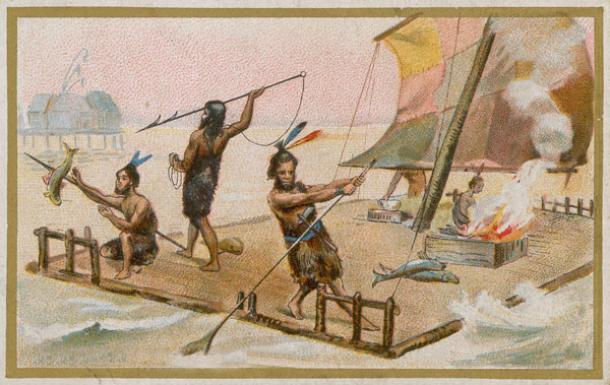Posted on 05/05/2018 9:08:13 PM PDT by Theoria
WASHINGTON, D.C.—Odysseus, who voyaged across the wine-dark seas of the Mediterranean in Homer’s epic, may have had some astonishingly ancient forerunners. A decade ago, when excavators claimed to have found stone tools on the Greek island of Crete dating back at least 130,000 years, other archaeologists were stunned—and skeptical. But since then, at that site and others, researchers have quietly built up a convincing case for Stone Age seafarers—and for the even more remarkable possibility that they were Neandertals, the extinct cousins of modern humans.
The finds strongly suggest that the urge to go to sea, and the cognitive and technological means to do so, predates modern humans, says Alan Simmons, an archaeologist at the University of Nevada in Las Vegas who gave an overview of recent finds at a meeting here last week of the Society for American Archaeology. “The orthodoxy until pretty recently was that you don’t have seafarers until the early Bronze Age,” adds archaeologist John Cherry of Brown University, an initial skeptic. “Now we are talking about seafaring Neandertals. It’s a pretty stunning change.”
Scholars long thought that the capability to construct and victual a watercraft and then navigate it to a distant coast arrived only with advent of agriculture and animal domestication. The earliest known boat, found in the Netherlands, dates back only 10,000 years or so, and convincing evidence of sails only show up in Egypt’s Old Kingdom around 2500 B.C.E. Not until 2000 B.C.E. is there physical evidence that sailors crossed the open ocean, from India to Arabia.
But a growing inventory of stone tools and the occasional bone scattered across Eurasia tells a radically different story. (Wooden boats and paddles don’t typically survive the ages.) Early members of the human family such as Homo erectus are now known to have crossed several kilometers of deep water more than a million years ago in Indonesia, to islands such as Flores and Sulawesi. Modern humans braved treacherous waters to reach Australia by 65,000 years ago. But in both cases, some archaeologists say early seafarers might have embarked by accident, perhaps swept out to sea by tsunamis.
In contrast, the recent evidence from the Mediterranean suggests purposeful navigation. Archaeologists had long noted ancient-looking stone tools on several Mediterranean islands including Crete, which has been an island for more than 5 million years, but they were dismissed as oddities.
Then in 2008 and 2009, Thomas Strasser of Providence College in Rhode Island co-led a Greek-U.S. team with archaeologist Curtis Runnels of Boston University and discovered hundreds of stone tools near the southern coastal village of Plakias. The picks, cleavers, scrapers, and bifaces were so plentiful that a one-off accidental stranding seems unlikely, Strasser says. The tools also offered a clue to the identity of the early seafarers: The artifacts resemble Acheulean tools developed more than a million years ago by H. erectus and used until about 130,000 years ago by Neandertals as well.
Strasser argued that the tools may represent a sea-borne migration of Neandertals from the Near East to Europe. The team used a variety of techniques to date the soil around the tools to at least 130,000 years old, but they could not pinpoint a more exact date. And the stratigraphy at the site is unclear, raising questions about whether the artifacts are as old as the soil they were embedded in. So other archaeologists were skeptical.
But the surprise discovery prompted researchers to scour the region for additional sites, an effort that is now bearing fruit. Possible Neandertal artifacts have turned up on a number of islands, including at Stelida on the island of Naxos. Naxos sits 250 kilometers north of Crete in the Aegean Sea; even during glacial times, when sea levels were lower, it was likely accessible only by watercraft. A Greek-Canadian team co-led by Tristan Carter of McMaster University in Hamilton, Canada, uncovered hundreds of tools embedded in the soil of a chert quarry. The hand axes and blades resemble the so-called Mousterian toolkit, which Neandertals and modern humans made from about 200,000 years ago until 50,000 years ago. These tools require a more sophisticated flaking method than Acheulean types do, including preparing a stone core before striking flakes off it.
Dating work on the artifacts is ongoing and Carter declined to comment pending publication. But Cherry says the Naxos evidence may be persuasive because it is well stratified, which means researchers should be able to date it more securely. “It is very convincing, because there are a lot more tools in situ,” adds Strasser, who, like Cherry, was not involved in the dig. “It is a quarry site littered with Mousterian stone tools.”
Other Paleolithic tools that appear to be Mousterian have been recovered on the western Ionian islands of Kefalonia and Zakynthos. The plethora of sites adds weight to the idea of purposeful settlement. “People are going back and forth to islands much earlier than we thought,” Simmons says.
But determining which of today’s islands were truly islands tens of thousands of years ago isn’t easy, as it depends on local land movements as well as broader sea-level changes, says Nikos Efstratiou, an archaeologist at Aristotle University of Thessaloniki in Greece. On the Aegean island of Lemnos, his team found what he thinks is a Paleolithic hunting camp dating back more than 10,000 years. But he can’t yet be sure when Lemnos was cut off from the mainland. Efstratiou adds that archaeologists need to better characterize the sorts of tools made on the mainland and the islands, so they can find links between the mainland and island peoples.
Other archaeologists are already reckoning with the possibility that humans and our cousins went to sea thousands of years earlier than had been thought. “We severely miscalculated,” admits Runnels, who excavated at the Crete site. If his colleagues are right, he says, “the seas were more permeable than we thought.”
Neanderthals were ancient mariners
Ancient hominids may have been seafarers
Anthropologist suggests Mediterranean islands inhabited much earlier than thought
Sail, ping.
I’ve generally found fair weather sailing to be fun.
Neanderthals keep turning out to have been more capable and smarter than previously thought.

"Wooden boats? Really? I'll have you know it was a Viking Cruise, main deck level balcony stateroom. The roasted duck with mango salsa was superb".
haha! Love it!!


This would mean Neanderthals were more technologically advanced than Sub-Saharan Africans of a mere 2000 years ago.
They still do— can be seen on any number of Mediterranean cruise ships... classic heavy forehead brow etc. Same hairdos too.
/s
Madagascar was settled not by Africans, but by people from Borneo/Indonesia. That’s something. ‘Africans’ didn’t arrive until 500+ years later, to that point on ‘discovery’.
I wonder how many times it took them to figure out the fire on a wooden boat thing?
Not necessarily.
But Sub-Saharan Africa is not well suited to preserve anything small. Still, there are tantalizing clues that the Okavango delta was once home to huge man made agricultural works sufficient to potentially feed a massive population. Where were the possible cities they fed? Their age is not known but if they are old enough the flooded coastal lands east of Africa around Madagascar, inundated at the end of the Younger Dryas, might be a place to look.
And Africa seems to have suffered less flooding than elsewhere, as there were great swaths of prime real estate in West Europe or Indonesia / South East Asia that disappeared after the last big ice age it’s really difficult to know what once was.
They weren’t progressives crowing about this time they can make Marxism work ... so they probably had no more problems than sailers of more recent eras,

Sub-Saharan Africans on their own never even made it to any of the islands off Africa. Every inhabited island off the coast of sub-Saharan Africa was first settled by non-Africans. That would put the Neanderthals of 100k+ years earlier ahead in the seafaring technology department.
Modern science in a nutshell. If the evidence doesn't fit what I "know" to be true, then that evidence should be ignored for ... reasons.
Keep in mind that Europeans and Asians have Neanderthal genes, and sub Saharan Africans don’t.
“Archaeologists had long noted ancient-looking stone tools on several Mediterranean islands including Crete, which has been an island for more than 5 million years, but they were dismissed as oddities.”
—
In a nut shell, that’s why human history is such a muddle ... like “climate change scientists” who only look for things that fit their theories and discard the rest (like the Sun).
Many an important artifact lies forgotten and moldering in museums’ basements or in the case of several thousand year old optically ground lens labeled ‘Jewry. “Just ‘oddities,’ move along and forget you ever saw those items, please. Look over there at that stunning statue of some unknown ruler we believe. We’re sure it was from a historic period and are waiting for the dating report due in a few years or so.”
This would mean Neanderthals were more technologically advanced than Sub-Saharan Africans of a mere 2000 years ago.
—
Actually not. Your supposition is wrong historically. The Sub-Saharan were far in advance of the Portuguese who discovered them in the 15th century, and considered the Sub-Saharan civilizations superior to their own (with clean running water and indoor toilets attached to a sewage system - inventions that were missing from Portugal at the time). The Portuguese even petitioned the Crown to be allowed to remain. (A Short History of Africa - Oliver & Fage).
These Sub-Saharan civilizations were likely the degenerated remains of the much older civilization - which the Old Kingdom Egyptians circa 2500 BC called the “Westerners” - and who ruled all of the North African-Mediterranean coast including the Nile Delta. Some of that civilizations remains can still be found Algeria and Libya, but just the odd arch or trilateral stone megalith.
It was after that point of discovery, when the Portuguese began trading with Arab Muslim slavers for slaves in exchange for firearms that the Sub-Saharan civilizations fell apart and their wooden cities returned to jungle ... thus giving rise to the later Western impression that Sub-Saharans were ignorant, stupid savages. That they never rebuilt was due to the loss of so many people to slavery, and to the Muslims who wished only to kill and convert.
Disclaimer: Opinions posted on Free Republic are those of the individual posters and do not necessarily represent the opinion of Free Republic or its management. All materials posted herein are protected by copyright law and the exemption for fair use of copyrighted works.